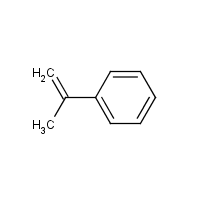alpha-Methyl styrene
Agent Name
alpha-Methyl styrene
CAS Number
98-83-9
Formula
C9-H10
Major Category
Plastics & Rubber

Synonyms
1-Methyl-1-phenylethene; 1-Methyl-1-phenylethylene; 1-MethylethenylBenzine; 1-Methylethylenebenzene; 1-Phenyl-1-methylethylene; 1-Propene, 2-phenyl-; 2-Phenyl-1-propene; 2-Phenylpropene; 2-Phenylpropylene; Benzene, (1-methylethenyl)-;Isopropenil-benzolo [Italian]; Isopropenyl-benzeen [Dutch]; Isopropenyl-benzol [German]; Isopropenylbenzene; alpha-Methyl-styrol [German]; alpha-Methylstyreen [Dutch]; alpha-Methylstyrene; alpha-Methylstyrol; alpha-Metil-stirolo [Italian]; as-Methylphenylethylene; beta-Phenylpropene; beta-Phenylpropylene; [ChemIDplus] UN2303; UN1993
Category
Styrenes
Description
Colorless liquid with a characteristic odor; [NIOSH]
Sources/Uses
Used as a polymerization monomer; [ACGIH]
Comments
Human subjects complained of an unpleasant odor and mild eye irritation. CNS depression possible after absorption of sufficient dose; TLV Basis: Irritation; Kidney & female reproductive damage; [ACGIH] A lachrymator; [CHEMINFO] A skin, eye, and respiratory tract irritant; Causes lachrymation; [ICSC]
Biomedical References
Exposure Assessment
Skin Designation (ACGIH)
Insufficient data
TLV (ACGIH)
10 ppm
PEL (OSHA)
Ceiling(OSHA) = 100 ppm
MAK
50 ppm
IDLH (NIOSH)
700 ppm
Excerpts from Documentation for IDLHs
Other animal data: A considerable number of rats and guinea pigs exposed to 3,000 ppm for 7 to 8 hours/day, 5 days/week for up to 6 months died [Gerarde 1960; Wolf et al. 1956]. Rats and guinea pigs had slight changes in liver and kidney weights and some reduction in body weight following exposure to 800 ppm for 7 hours/day, 5 days/week for 27 days [Wolf et al. 1956]. No adverse effects were noted in rats, rabbits, mice, monkeys, and guinea pigs exposed 7 hours/day, 5 days/week for 5 months to 200 ppm [Wolf et al. 1956]. . . . Human data: Four volunteers reported a definite unpleasant odor and slight eye irritation after about 2 minutes of exposure to 200 ppm [Wolf et al. 1956]. Strong eye and nasal irritation has been noted at concentrations above 600 ppm [Gerarde 1960; Wolf et al. 1956].
Vapor Pressure
1.9 mm Hg
Odor Threshold Low
0.052 ppm
Odor Threshold High
0.16 ppm
Lethal Concentration
LCLo (rat) = 3,000 ppm
Explanatory Notes
Odor threshold (detection at 0.052 ppm and recognition at 0.16 ppm) from CHEMINFO; Flash point = 84 deg C; VP from HSDB;
Adverse Effects
Lachrymator
Yes
Neurotoxin
Acute solvent syndrome
Reproductive Toxin
Yes
IARC Carcinogen
Possible (2b)
ACGIH Carcinogen
Confirmed Animal
Diseases, Processes, and Activities Linked to This Agent
Diseases
Occupational diseases associated with exposure to this agent: